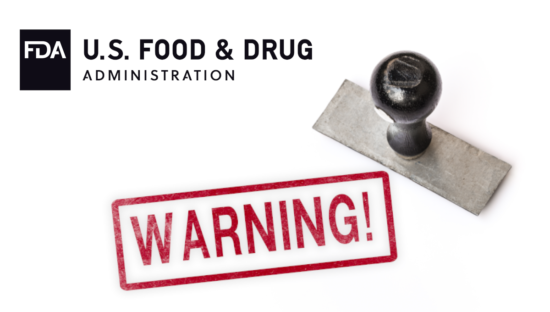As part of its enforcement activities, the Food and Drug Administration sends warning letters to entities under its jurisdiction. Some letters are not posted for public view until weeks or months after they are sent. Business owners have 15 days to respond to FDA warning letters. Warning letters often are not issued until a company has been given months to years to correct problems.
Yongdae Hwangtae Union Corp Daeryung
Bung-Myeon Inje-gun Gangwon-do
South Korea
The FDA conducted an inspection of the seafood processing facility, Yongdae Hwangtae Union Corp Daeryung 10-30 Wontongro74beon-Gil, Bung-Myeon, Inje, Gangwon Korea (the Republic of) 24621 on June 27-28, 2024. During the inspection, the agency found that serious violations of the Seafood HACCP regulation (21 CFR 123). At the conclusion of the inspection, the FDA investigator issued an FDA-483, Inspectional Observations that lists the observations made at your firm.
In accordance with 21 CFR 123.6(g), failure of a processor of fish or fishery products to have and implement a HACCP plan that complies with this section or otherwise operate in accordance with the requirements of Part 123, renders the fish or fishery products adulterated within the meaning of section 402(a)(4) of the Federal Food, Drug, and Cosmetic Act (the Act), 21 U.S.C. § 342(a)(4). Accordingly, your refrigerated and frozen desalted pollack in modified atmosphere packaging products are adulterated, in that they have been prepared, packed, or held under conditions whereby they may have been rendered injurious to health.
Significant deviations are as follows:
1. Your finished product of dried pollack is considered a ready-to-eat (RTE) food by FDA because it may appear as a dried RTE food and be eaten without cooking by the consumer. This dried pollack is also considered raw by FDA because it does not receive a verified listericidal thermal treatment to eliminate pathogens (i.e., it is not cooked or dried at cooking temperatures). As a processor of a raw RTE product you must have appropriate sanitation and process controls for pathogen growth and toxin formation throughout processing. These controls should begin after the receipt of frozen pollack from your supplier, and include the (redacted) performed at your outdoor (redacted) location at the base of a mountain, the refrigerated storage of the dried pollack with unknown water activity in your warehouse, rehydration of the air-dried pollack, pressing and tearing the pollack into strips by hand, (redacted) pollack in an oven at (redacted) degrees C ((b)(4) degreesF) and reduced oxygen packaging.
Your food safety controls for processing in your plant are not adequate as all operations in the manufacturing, processing, packing and hold of food must be conducted in accordance with adequate sanitation principles. Raw materials must be clean and suitable for processing and stored under conditions that will protect from contamination as required by 21 CFR 117.80 (a) and (b). Your firm operates an outdoor (redacted) location where pollack is (redacted) exposed to the natural environment on (redacted) stakes for (redacted) months in the winter at ambient temperatures of (redacted) degreesC ((redacted) degreesF). This (redacted) process does not protect the pollack that is considered a raw RTE food from contamination with filth including pathogens (e.g., animal poop including birds and insects). The (redacted) pollack with unknown water activity is then stored refrigerated in a warehouse until further processing within your processing plant. Your hazard analysis and HACCP must control food safety hazards that can be introduced both within and outside the processing plant environment to comply with 21 CFR 123.6 (a) and (b). Thus, your processing of outdoor air-drying in addition to the processing in your plant must protect the pollack from contamination with biological, chemical, and physical food safety hazards.
Additionally, your food safety controls for processing in your plant are not adequate due to the following.
2. You must have a HACCP plan that at a minimum, lists the critical limits that must be met, to comply with 21 CFR 123.6 (c)(3). A critical limit is defined in 21 CFR 123.3 (c) as “the maximum or minimum value to which a physical, biological, or chemical parameter must be controlled at a critical control point to prevent, eliminate, or reduce to an acceptable level the occurrence of the identified food safety hazard. However, your firm’s HACCP plan for “Dried Sliced Pollack” dated 2022-08-01 at the (redacted) critical control point (CCP) lists a critical limit of “(redacted)” that is not adequate to control pathogen growth and toxin formation including Clostridium botulinum. Because your RTE dried pollack is intended to be shelf-stable and is in reduced oxygen packaging your critical limit should ensure the finished product achieves a water activity of (redacted) or less to control pathogens including C. botulinum. Additionally, because your (redacted) temperature is (redacted) degreesC ((redacted) degreesF) which is in the temperature range for unrefrigerated processing (redacted) degreesC ((redacted) degreesF) and not a thermal process that will eliminate pathogens, the cumulative time exposure to temperatures in unrefrigerated processing should not exceed two hours to control pathogen growth and toxin formation other than C. botulinum. The cumulative time exposure for unrefrigerated processing would end once the product achieves (redacted) or less water activity. The cumulative time for unrefrigerated processing should include additional processing steps that are performed at ambient air temperatures such as the rehydration, pressing, and tearing of pollack. Your critical limits should list the critical factors as established by a scientific study to achieve a water activity of (redacted) or less in the finished product and for the water activity to be achieved within (redacted) cumulative hours of unrefrigerated processing.
3. Because you chose to include a corrective action plan in your HACCP plan, your described corrective actions must be appropriate, to comply with 21 CFR 123.7 (b). Corrective actions are to prevent the distribution of adulterated food into commerce and correct the cause of the deviation. However, your (redacted) CCP lists corrective actions of redrying or discarding product without actions to correct the cause of the deviation such as adjustments or repairs to oven or modifications to (redacted) procedure. Also redrying should only occur if it does not jeopardize the safety of the product.
4. You must conduct or have conducted for you a hazard analysis for each kind of fish and fishery product that you produce to determine whether there are food hazards that are reasonably likely to occur and have a HACCP plan that, at a minimum, lists the food safety hazards that are reasonably likely to occur, to comply with 21 CFR 123.6 (a) and (c) (1). A food safety hazard is defined in 21 CFR Part 123.3 (f) as “any biological, chemical, or physical property that may cause a food to be unsafe for human consumption.” However, your firm’s HACCP plan for dried pollack does not list the food safety hazard of undeclared allergens such as finfish (i.e., pollack).
(To sign up for a free subscription to Food Safety News, click here)



